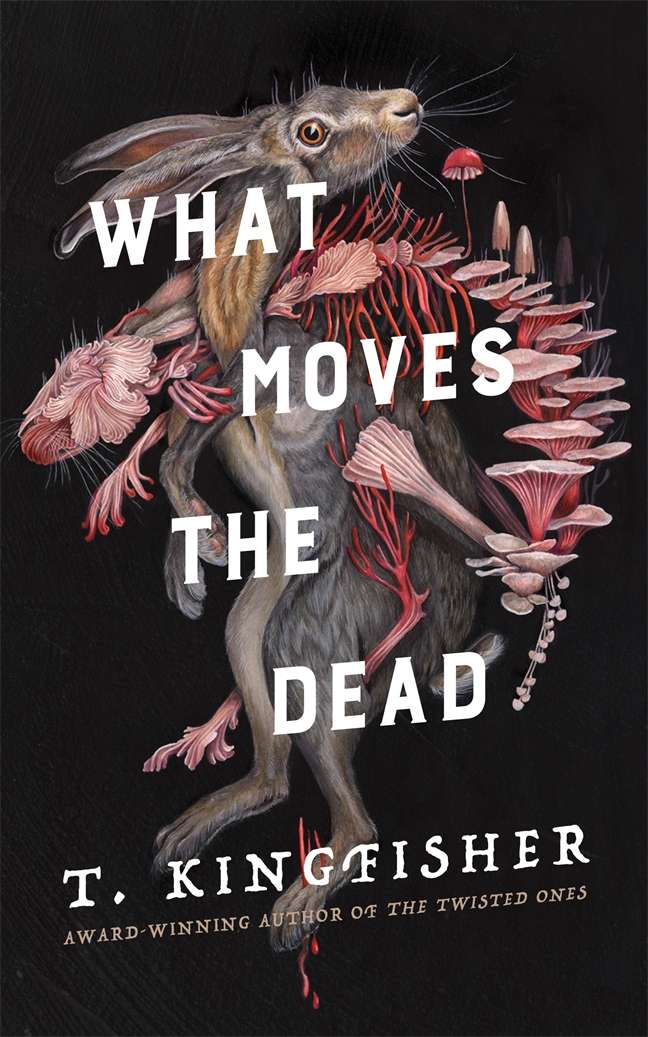We are upgrading our email system over this weekend (13th-14th of December). Please do not send us emails over this weekend as they may be at risk of getting lost.

For all things fantasy, horror, and speculative fiction
Announcement:

What Moves the Dead by T. Kingfisher from @TitanBooks
What Moves the Dead by T. Kingfisher
Titan Books, pbk, £8.99
Reviewed by Ian Hunter

Told over 169 pages and 13 chapters, What Moves the Dead is a short novel riffing off Edgar Allan Poe’s very short story “The Fall of the House of Usherâ€. This time following the story of Alex Easton, a retired, world-weary soldier who served in the Gallacia army with Roderick Usher. Easton has travelled to a remote rural part of Ruravia to visit the Usher estate on the bequest of Roderick’s sister, Madeline, who is seriously ill, possibly dying, or so her brother believes. On the way, we are treated to Kingfisher’s narrative powers as she describes the bleak, decaying rural landscape, which doesn’t improve when Easton arrives at an equally decaying Usher mansion that is cold and riddled with mould and dampness. No wonder the siblings look ghastly, without heat and barely anything to eat. Both are emaciated, stick-thin and very pale, with wisp-like hair on their heads, and Easton can’t help but notice the white hairs on Madeline’s arms. Things aren’t helped by Madeline’s fascination with a black-looking tarn behind the house, which she regularly visits to stand beside and peer into. In fact, according to an American doctor called Denton, who is staying with the Ushers, Madeline once fell into the tarn, and her seemingly lifeless body had to be pulled from the water.
As Easton stays with the Ushers, what follows is a heightening story of dread and terror involving the tarn, the local landscape, and hares, which don’t act like hares in that they don’t run anyway from humans. In fact, they seem to gather and study anyone who comes across them, and they move very oddly. They are clearly not to be eaten, according to the locals, and Easton manages to resist shooting one for much-need food and eventually resorts to buying a cow from a local farmer to stock the Usher pantry and concocts a story that he accidentally shot it, as he doesn’t want to offend Roderick by providing food for him by normal means.
Things are weird enough outside the house, but there is an increasing feeling of dread and despair and paranoia inside as tensions rise between all the major characters, and it isn’t helped by the sound of someone moving around the corridors at night, and eventually, Easton discovers that it is Madeline walking in a trance-like state, but also moving oddly, rather like the hares and speaking some strange language.
Given that this is a short novel, that is enough of the plot; suffice to say that the reader does grow to care for the characters, and I was reminded of the film “The Thing†given the claustrophobic setting of the story, the bleak surroundings, the character dynamics, and some shocking revelations – no spoilers here.
What also makes this story enjoyable are the characters themselves, particularly Easton, who is a non-binary “sworn†soldier, which comes with its own set of pronouns, and a minor quibble would be the little bit of info-dumping that slows the plot down as the history and use of these pronouns are explained, but Easton is a great character with a dry, black, biting wit, who is also fond of a tipple and desperate to help a former colleague and his sister, but really at a loss as to how to help. Likewise, Denton is equally out of his depth, especially as his experience is mainly being an army doctor, spending most of his time amputating the limbs of wounded soldiers. Added to the character mix are two interesting supporting characters. The first is a redoubtable Englishwoman, Miss Eugenia Potter, who is an amateur mycologist studying all the local fungi, and if her surname sounds familiar, she does mention having a niece who is fond of drawing. The second is Easton’s servant Angus, a Scot, who grumbles about everything – the house, the surroundings, the strange hares, the innards of fish he has caught and Easton’s antics.
“What Moves the Dead†is genuinely creepy in places, especially as Alex encounters the strange local hares and during his night-time excursions – following – then later in the company of Madeline, although the first person telling of the tale does dilute the sense of jeopardy a little bit. That aside, this is my first-time reading Kingfisher’s work, and I’ll certainly be joining her for more.